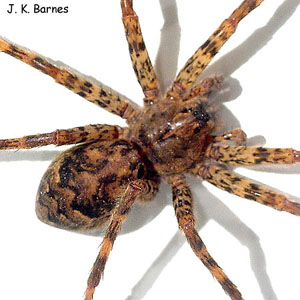Dark fishing spider
Order: Araneae
Family: Pisauridae
Genus and species: Dolomedes tenebrosus Hentz




When the dark fishing spider shows up in Arkansas homes, it can cause much excitement. The large female has a body (cephalothorax and abdomen) that reaches about 1” long. When outstretched legs are included in the measurements, the animal can measure over 3” long. Males are about half this size. The body is a mixture of light brown and light and dark gray. The legs have dark rings and long spines. The abdomen has 3 conspicuous black W-shaped marks, each of which ends in a light brown mark. This species occurs from southern Canada south to Florida and west to Texas and the Dakotas. Adults can be found throughout late spring and summer. The spiders tend to lurk in corners and crevices during the day, and they hunt actively after dark.
North American pisaurids are all wandering spiders, stalking their prey rather than snaring it in webs. The members of the genus Dolomedes are the “fishing spiders.” Unlike wolf spiders, which they resemble in their giant size, they typically live near water. They run freely over water in pursuit of prey, including small fish (Barbour 1921) and aquatic insects. When frightened, they may dive beneath the surface. Dark fishing spiders are, however, opportunistic, generalist feeders, and they have even been known to consume slugs despite their sticky mucous (Kissane 2001). Usual habitats for D. tenebrosus are swamp, pond, and lake margins, where it may be found on tree trunks, rocks, logs, and similar situations. Individuals are also found in dark and damp situations beneath bridges or culverts, or in rock piles. Although the dark fishing spider is often found near water, this species is not as well adapted to an aquatic environment as some other Dolomedes species. Individuals sometimes stray quite far from water and may even be found in dry wooded areas. Some individuals enter houses, where they may be found in basements, kitchens, and even bedrooms (Carico 1973).
Spiders of the family Pisauridae are often called nursery-web spiders. It is likely that this species spends the mating season in the vicinity of water (Bishop 1924). Mating behavior has been recorded only once, and in that case the female terminated copulation by killing the male (Sierwald and Coddington 1988). The large egg sac of D. tenebrosus, measuring up to 14 mm in diameter, is spherical, and it is held in place under the mother’s body by her chelicerae and pedipalps. Individual sacs have been known to contain nearly 1400 eggs (Kaston 1981). Shortly before the eggs hatch, the mother attaches the sac to vegetation, builds a nursery web around it, and stands guard nearby. The young live in the nursery web for some time after hatching (Emerton 1902). It is likely that the dark fishing spider requires more than one season to mature, at least in the northern parts of its range (Bishop 1924).
It has been reported that adult female Dolomedes tenebrosus can have a menacing demeanor, striking viciously without yielding ground when harassed (Fitch 1963). Because of their large size, the fangs are certainly able to penetrate human skin. However, reports of humans being bitten by Dolomedes species are rare. A single known report indicates immediate burning pain at the site of the bite, followed by redness and minor local tissue necrosis (Sams et al. 2001).
Dolomedes scriptus Hentz is similar to D. tenebrosus, but it has more pronounced W-shaped white marks associated with the black marks on the abdomen. Technical female and male sexual characteristics are the best way to distinguish the species. Although spiders of the family Pisauridae resemble some wolf spiders in their giant size, they can be distinguished by the arrangement of the eyes. Nursery-web spiders have eight eyes arranged in two rows of four each, whereas wolf spiders have eight eyes arranged in three rows, with the two eyes of the middle row by far the largest.
References:
Barbour, T. 1921. Spiders feeding on small cyprinodonts. Psyche 28: 131-132.
Bishop, S. C. 1924. A revision of the Pisauridae of the United States. New York State Museum Bulletin 252: 140 pages.
Carico, J. E. 1973. The Nearctic species of the genus Dolomedes (Araneae: Pisauridae). Bulletin of the Museum of Comparative Zoology 144 (7): 435-488.
Emerton, J. H. 1902. The common spiders of the United States. Ginn and Company, Publishers, Boston. 225 pages.
Fitch, H. S. 1963. Spiders of the University of Kansas Natural History Reservation and Rockefeller Experimental Tract. University of Kansas Museum of Natural History, Lawrence. 202 pages.
Kaston, B. J. 1981. Spiders of Connecticut. State Geological and Natural History Survey of Connecticut, Department of Environmental Protection Bulletin 70: 1020 pages.
Kissane, K. C. 2001. Slug eating by the pisaurid spider Dolomedes tenebrous Hentz, 1843. British Arachnological Society Newsletter 91: 4-5.
Sams, H. H., C. A. Dunnick, M. L. Smith, and L. E. King. 2001. Necrotic arachnidism. Journal of the American Academy of Dermatology 44: 561-573.
Sierwald, P., and J. A. Coddington. 1988. Functional aspects of the male palpal organ in Dolomedes tenebrosus, with notes on the mating behavior (Araneae, Pisauridae). Journal of Arachnology 16: 262-265.
